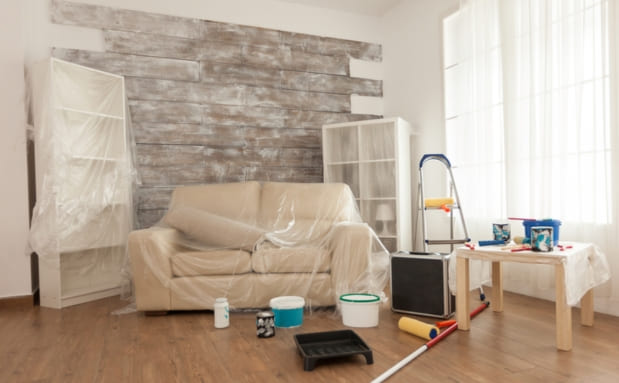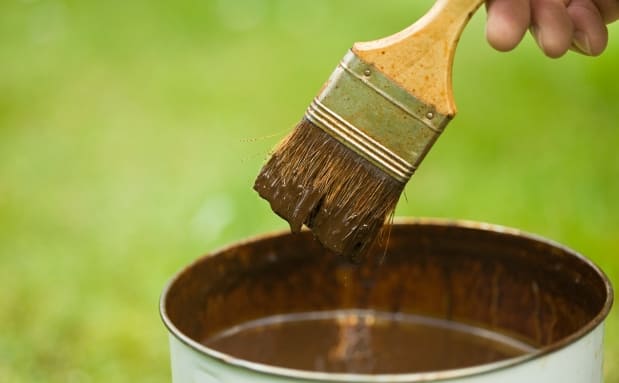Are you considering making a room in your house look new and improved? Painting has the ability to change the feel of a space, making it seem cleaner, brighter, and larger. Wondering “How Much Does It Cost To Paint A Room?” While taking on a painting project yourself might seem tempting, it can turn into a time-consuming endeavor with potentially less-than-perfect results.
To help you get a clear idea of what painting a room might cost, we’ve gathered insights from experts at HomeAdvisor. This trusted service connects homeowners with skilled contractors, and their expertise and openness can give you valuable information about estimating painting expenses.
In this article, we will explore the factors that influence painting prices more thoroughly. These factors include materials cost, hiring a local painter, project complexity, and more. Let’s begin!

Table of Contents
- cost to paint a room per square foot
- How much to paint a room?
- How much to charge to paint a room?
- Step 1: Measure the Room
- Step 2: Determine Paint Quantity
- Step 3: Select Paint Type
- Step 4: Calculate Paint Cost
- Step 5: Surface Preparation
- Step 6: Labor Costs
- Step 7: Additional Materials
- Step 8: Calculate Total Cost
- Step 9: Consider Other price to paint a room
- Step 10: Get Multiple Quotes
- Step 11: Use a Paint Calculator
- How much does a handyman charge to paint a room
- House Painting Costs:
- Factors that Affect Cost to Paint a Room
- Location
- Timing
- Room Size
- Wall Height
- Primer
- Color
- Type of paint
- Additional Costs
- Conclusion:
- Rosalie Sanchez
cost to paint a room per square foot
On average, interior painting jobs cost between $968 and $3,039, with the national average being around $1,983. The price largely depends on the square footage you’re covering, considering both materials and labor. This usually costs about $2 to $6 per square foot. Typically, larger rooms and spaces typically incur higher costs due to the larger area to paint. (Home Advisor)
Speaking of specifics, the typical expense to paint a single room ranges from approximately $350 to $3,000, depending on the room’s size.
Useful Resource: When planning your home paint projects, consider standard paint can sizes to ensure you have enough paint.
How much to paint a room?
| Home Painting Price | |
| Average cost to paint a room | $1,983 |
| Painting cost Range | $968 – $3,039 |
| Lowest to Highest | $350 – $5,500 |
How much to charge to paint a room?

It is necessary to consider various cost factors when calculating paint costs for a room. Using the following steps, you can calculate the cost:
Step 1: Measure the Room
Start by measuring the walls and the ceiling, considering their length, width, and height. This will give you the room’s dimensions, allowing you to calculate the total square footage of surfaces that require painting.
Step 2: Determine Paint Quantity
Consider the type of paint you intend to use, its coverage rate, and the number of coats needed. Most paint cans indicate coverage in square feet per gallon. To calculate the quantity of paint required, divide the overall area by the coverage rate.
Step 3: Select Paint Type
High Quality Brands like Sherwin Williams offer different paint prices based on finishes like matte, satin, semi-gloss, or gloss. Make your selection and verify the gallon cost.
Step 4: Calculate Paint Cost
Calculate the overall paint expenses by multiplying the estimated gallons required by the price per gallon of the selected paint. This will give you an approximate paint cost.
Step 5: Surface Preparation
Factor in expenses for preparing the surfaces, including patching, sanding, priming, and any necessary repairs. The extent of preparation can influence these costs.
Step 6: Labor Costs
Choose whether to enlist professional painters or take on the project personally. If you want to hire professionals, obtain quotes from different painters to account for labor charges.
Step 7: Additional Materials
If you’re tackling the project yourself, consider the cost of tools such as painter’s tape, brushes, rollers, ladders, and drop cloths.
Step 8: Calculate Total Cost
The total cost includes the paint, surface preparation, labor, and additional materials. Sum up all these expenses to get a comprehensive estimate.
Step 9: Consider Other price to paint a room
Plan for unexpected costs, such as repairs or touch-ups after painting.
Step 10: Get Multiple Quotes
When hiring professional painters, it’s advisable to seek quotes from various contractors. This enables you to compare prices, services, and reviews.
Step 11: Use a Paint Calculator
For a more precise estimate, utilize online paint calculators provided by paint manufacturers. These calculators factor in room dimensions, windows, doors, and paint type.
How much does a handyman charge to paint a room
Painting your house can be a big investment that changes how your home looks. The cost of hiring a professional painter can change depending on things like how large the project is. This can also depend on what kind of property you have, and how experienced the painter is. This section provides an overview of potential painting costs to aid informed decisions when hiring a painter.
House Painting Costs:
Cost per Area:
Many painters charge based on how much space needs to be painted. The usual cost for each square foot is $3.50 or more. The exact expenses can vary based on the factors I mentioned earlier in this discussion.
Hourly Cost: Some painters charge by the hour, and this can be between $25 and $75 or even more per hour.
Cost per Room:
If you’re painting just one room, painters might give you a fixed cost based on how long and hard the room is. This might be between $150 and $2,000. This range also includes things like the type of paint, getting ready for the area, and doing extra details.
Cost per Project:
For larger projects like painting the whole outside of a house or many rooms might be given a set price for the whole job.
For Homeowners:
When painting the outside of your house, it’s important to plan your budget well. On average, people usually pay about $8,000 for painting a house that’s around 2,300 square feet. This cost covers workers, materials, and painter skills. Just so you know, prices can change depending on when you do it and how tough the project is.
Condo Painting Costs:
Check Condo Rules: If you live in a condo, it’s really important to read the rules of your homeowners association (HOA) before painting. Some condos have rules about colors, and this might affect your decision. Always follow these rules to avoid problems.
Cost for a Regular-Sized Condo: Painting the inside of a regular-sized condo of 1,200 square feet might cost $4,200. This covers the cost of workers, materials, and surfaces preparation. But the prices can change based on things like how many rooms there are, how the walls are, and what kind of finish you want.
Apartment Painting Costs:
The cost of painting an apartment can change depending on things like how spacious it is, how many rooms it has, how good the paint is, where it is, and whether you do it yourself or hire someone. For a regular one-bedroom apartment, painting might cost between $800 and $3,000 if you hire a professional.
Factors that Affect Cost to Paint a Room
Painting costs are shaped by various factors, impacting the final expenditure. An accurate estimation of your painting budget requires an understanding of these factors. The following factors affect the cost of painting a room:
Location
Painting costs can fluctuate based on location, with urban regions having higher living costs often resulting in more expensive painter rates. Rates can differ substantially between painters across the country.
Keep in mind that regions with high living costs often correlate with higher painting expenses. Hence, when assessing potential expenses, consider geographical location’s influence on pricing variations within the painting industry.
Timing
Seasonal timing also matters, with interior painting often more affordable during fall and winter due to reduced demand and increased contractor availability.
Room Size
Room size significantly influences painting costs. Larger rooms demand more paint, time, and effort, increasing expenses. This is especially true for spaces with intricate layouts or high ceilings.
For instance, a bathroom (70 sq. ft.) could cost around $150-$300, while a living room (330 sq. ft.) might range from $900-$2,000. Room size directly impacts supplies needed, leading to cost variations.
Wall Height
Wall height significantly impacts painting costs. Taller walls require more paint and labor due to the increased surface area. Rooms with ceilings over 10 feet can raise costs by 10% to 50% or more. High ceilings necessitate extra equipment and safety precautions.
Textured walls, like the popular orange peel, enhance aesthetics but increase costs by up to 50% due to extra paint demands. Estimate accurately by factoring in wall texture and height for professional painting quotes.
Primer
Primer costs range from $10 to $30 per can and are a crucial step often overlooked. It enhances the final appearance and durability of the paint job. For optimal adhesion and longevity, it’s essential when dealing with porous surfaces like new drywall or glossy, dark, or odorous areas. Some paints are combined with a primer, saving time and costs.
Water-based primers are ideal for walls and ceilings, while oil-based are for doors, windows, metal, and woodwork. For issues like water damage or mold stains, a stain-blocking primer proves effective. Prioritizing primer application contributes to a smoother, longer-lasting finish.
Color
The chosen paint color significantly affects project costs. Transitioning from light to dark or vice versa may demand extra coats, increasing material and labor expenses, particularly for vibrant or deep shades.
Painting rooms in different colors is more expensive because there is likely to be leftover paint. Opting for a uniform color across your house or rooms can save you money. Costs hinge on both desired and existing colors – light over dark may incur more expenses.
Complex shades like red or black might necessitate a heavy-duty primer and multiple coats. Sticking to one color for multiple rooms saves paint quantity and efficiency.
Type of paint
The choice of paint type and finish is a significant consideration for painting projects. Paints are broadly categorized into latex-based and oil-based varieties, each with distinct advantages.
Latex-based paints are well-suited to living spaces, while oil-based paints excel in moisture-prone areas like bathrooms and kitchens.
Various finishes also play a role: flat paint is suitable for dry spaces, eggshell and satin offer versatility, and semi/high-gloss finishes are ideal for trim.
Investing in quality paints proves worthwhile due to their improved durability and visual attractiveness. Selecting the right paint type and finish ensures budgeting and desired, long-lasting results.
Additional Costs
Crafting a comprehensive budget for a room-painting project necessitates consideration of additional expenses. Estimation techniques employed can lead to substantial labor cost variations.
Professionals might charge hourly, averaging $20 to $50 per hour, or by square foot or floor area. Flexibility is key, as rates fluctuate. Extra expenses encompass various aspects.
- Wall Preparation: This involves cleaning, patching, and priming the walls, usually costing around $50 to $200 depending on the size and condition of the walls.
- Repairs: Addressing substantial drywall damage, like cracks or holes, can range from $100 to $400 per repair, impacting the overall project budget.
- Trim: Painting baseboards, moldings, and architectural details adds an extra expense of $1 to $4 per linear foot, contributing to the room’s overall aesthetic.
- Ceiling: Painting the ceiling, which can be more intricate due to its position, usually adds $1 to $2 per square foot to the total cost.
- Mold Removal: Ensuring a mold-free environment before painting involves an additional cost of $15 to $30 per square foot, depending on the extent of the issue.
- Lead or Asbestos Testing: Detecting hazardous materials comes at a price, ranging from $250 to $750, but ensures safety during painting.
- Cleanup: Properly cleaning the space after painting may incur an additional fee, ensuring the area is left tidy and ready for use.
Conclusion:
In conclusion, the cost of painting a room can vary significantly based on factors like room size, paint quality, labor expenses, and additional preparation requirements. You must obtain accurate quotes from professionals and include all the elements for a realistic budget. Remember, investing in quality often leads to better, longer-lasting results.

Rosalie Sanchez
DIY enthusiast with years of experience in home decor and home improvement. With a passion for educating consumers about DIY projects. Every time, I work with our painting professionals to provide you with the best painting product reviews and how-to advice. You can follow me on Facebook.


